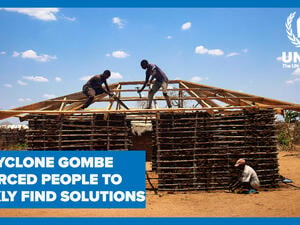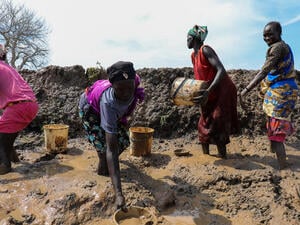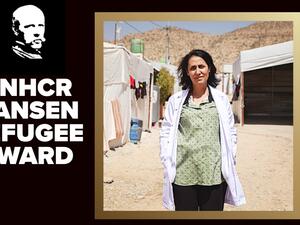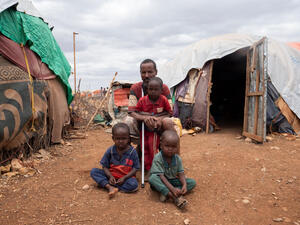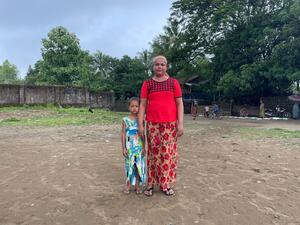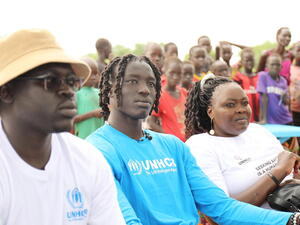UNHCR urges Ukraine to establish central registration system as internal displacement tops 117,000
UNHCR urges Ukraine to establish central registration system as internal displacement tops 117,000

A UNHCR staff member asks a displaced Ukrainian man about the situation in his native Donetsk region, which has been heavily affected by the conflict. He is cleaning debris from around his home.
GENEVA, August 5 (UNHCR) - Amid a worsening situation in eastern Ukraine, the UN refugee agency on Tuesday estimated that more than 117,000 people are now displaced inside Ukraine. "In the past seven days more than 6,200 people have been forced from their homes," UNHCR's Vincent Cochetel told journalists in Geneva. As of August 1, an estimated 168,000 people have crossed into Russia so far this year.
Cochetel noted that the number of people displaced from the Luhansk and Donetsk regions had risen sharply from 2,600 in early June to 102,600 at the start of this month. People from eastern Ukraine now make up 87 per cent of the total displaced population in Ukraine; those from Crimea number some 15,200 people.
He added that, with numbers rising, UNHCR was calling on the Ukrainian government to establish a central registration system of internally displaced people (IDP). "The current lack of a systematic and uniform system hampers the coordination and implementation of relief efforts. This is also important as the Ukrainian authorities make their preparations for winter. Most of the current shelters in use are not suitable for the cold winter months," he said.
People are fleeing eastern Ukraine with limited belongings. They face increasing difficulties, including access to banking services. Basic services and infrastructure have been heavily affected by the increased violence, with scarcity of drinking water becoming increasingly common. Many houses and buildings have been partially or totally destroyed by conflict in the Donetsk and Luhansk regions.
Cochetel said UNHCR was also seeing a mixed picture of displacement with a significant increase of people fleeing violence around Horlivka, Donetsk and Luhansk as well as a substantial number of returns to areas where the Ukrainian government has regained control.
According to local authorities, some 4,000 people have returned from the Kharkiv region to Slavyansk and Kramatorsk during the last week. Some 20,000 people have reportedly returned to Slavyansk since July 5.
The displaced cite security concerns, including the risk of being caught in crossfire, as the main reason for leaving their homes. Some people also expressed fears of persecution for their political views or ethnicity while others worried about forced recruitment by either side. Some talked of incidents of abduction, extortion and harassment in their neighbourhoods. Others cited damage to homes or infrastructure as well as lack of services for fleeing.
UNHCR continues to support government and civic society in their response to the displacement, as well as provide aid directly to the most vulnerable. The agency has delivered hygiene items and kitchen sets to some 15,000 returnees in Slavyansk, Donetsk region.
Most internally displaced people are hosted by friends or families while some are renting accommodation. UNHCR has started a cash assistance programme to support more than 700 IDPs in the Lviv and Vinnytsia regions.
Last week, UNHCR signed a cooperation agreement with the Donetsk regional authorities to open a field office in Mariupol to support government officials and coordinate the distribution of aid to the most vulnerable displaced people. The first delivery of aid, including food, took place last week in the town of Yalta and another shipment is planned in the coming days for Donetsk's Pryazovskiy district, which hosts more than 20,000 IDPs.
Most Ukrainians leaving their country are not applying for refugee status. They often seek other legal status. Some fear applying for refugee status will lead to complications and they consider the alternatives available a better temporary solution.
According to Russian authorities, 168,677 displaced people applied to the Federal Migration Service in the first seven months of this year. These included 6,347 for refugee status, 48,914 for temporary asylum, 28,134 for citizenship, 59,858 for temporary residence, 19,943 for residence permits and 5,481 under the programme of resettlement of compatriots.
A larger number of Ukrainians are arriving and staying in Russia under the visa-free regime. The Russian authorities estimate that around 730,000 Ukrainians, including the 168,000 seen by the Federal Migration Service, have arrived since the beginning of the year under this programme.
Around 80 per cent of Ukrainians are staying in border areas, while others are moving to stay with friends or relatives in other parts of the country. More than 585 temporary accommodation facilities are hosting 42,486 people. The Russian authorities have adopted several regulations to facilitate the temporary stay of Ukrainians arriving on its territory.

